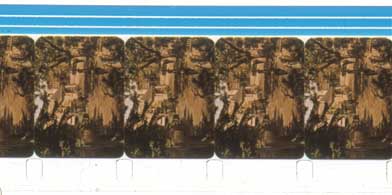the time (1963) when double rank entered the picture. At this time,
curiously, all single-rank prints started coming through with black
sprockets, from the track negative. Double rank was always
clear-sprocketed in its short existence, approximately 1963 to 1971, when
the special printers (two-prints at a time, split down the middle) were
dismantled. Single rank, from 35mm equipment, lasted a few more years,
until all IB had been phased out by early 1974.

Neither is necessarily better. There could be sub-par printing from both
formats, but double-ranks were generally more consistent by virtue of
newer matrices. Because of pins (for sprockets) on both sides of the
double-rank printer, it was thought there was less movement, but movement
was rarely a problem in either format. Some single-ranks were struck from
matrices as old as 20 years. From such aged matrices, there could be
shocking color changes from unit-to-unit, as in certain copies of "The
Adventures of Robin Hood." There could be perfect matches, as in the
newer, black-sprocket prints of "Scarlet Angel."

There was an improvement in IB resolution in 1955, circa mid-year. Focus
was upped an estimated 50%, in response to Eastman's superior sharpness
on wide-screen projection. IB prints manufactured before this period
tend to be soft, some softer than others. This includes all blue-track
prints. The earliest silvers had the same look, but with an improved
track. These old prints can also vary today depending upon how seriously
they were doused with film cleaners, which could cause the dyes to
migrate.

All 16mm IB prints were blue-track from the inception in 1944 until the
end of 1951. An "Alice in Wonderland" from '51 is one of the most recent
blue-tracks. When IB returned a few months later, in early 1952, it was
silver forevermore.